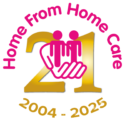Disability Recruitment & Retention report
April 2025
At Home From Home Care we employ numerous employees with different disabilities. Currently 23% of our workforce comprises of colleagues who have a disability. This has been an increase from 15% in 2022. Over the past 5 years we have developed the foundation for health and wellbeing to actively encourage candidates to apply as well as to ensure we can retain and support employees with varying needs in physical and mental health.
Home From Home Care introduced our internal Wellbeing Team in 2020 and since then it has grown and become a respected and established team. Our Wellbeing team are embedded within the homes and are able to engage with colleagues on issues that might be affecting them either in work or on a personal basis. They are all mental health first aid trained but their primary role is to sign post colleagues to the different areas of support.
The areas of support that can be offered vary from:
- Occupational Health referrals
- Identifying reasonable adjustments with the home manager
- Counselling referrals through the Westfield Health benefit
Currently 40% of colleagues are actively engaging with the wellbeing team for varying reasons. This has led to an increase in the number of reasonable adjustments we have put into place within the workplace with 32% of the workforce with a risk assessment or reasonable adjustment in place.
These include but are not limited to:
- Mental Health Action Plans
- Neurodiversity support plans
- Reasonable adjustments i.e epilepsy monitor to enable a colleague to lone work.
All colleagues receive an occupational health screening assessment as part of the onboarding process, this enables any reasonable adjustments to be identified early in the employment life cycle The wellbeing team have seen a steady rise of occupational health referrals especially in the last 12 months with 17% of colleagues having received an occupational health referral.
In April 2024 Home From Home Care introduced a new benefit for all contracted houred colleagues, a health cash plan which included access to a GP 24/7 as well as free face to face counselling.
As an organisation we have seen a decrease in our employee turnover since 2020 and we are retaining employees far more effectively than we have ever done.
The % of individuals within your organisation who consider themselves to be disabled or have a long term physical or mental health condition.
23% of those who have filled in their form are disabled or long term health condition.
Colleagues complete their supplementary personal details form when they commence employment. This is an anonymised form and asks different questions on the demographics such as ethnicity, country of birth. It asks the following question:
“Do you consider yourself to have a disability or long term health condition?”
A further question is then asked providing a drop down of the different types of disabilities or long term health conditions:
Mental Health | 10.68% | Prefer not to say | 3.3% | Stamina or difficulty breathing | 1.17% |
Other impairment | 4.85% | Social or behavioural issues (eg due to autism, attention deficit disorder or Aspergers syndrome) | 2.52% | Hearing (eg due to deafness or partial hearing) | 0.97% |
Learning, concentrating or remembering | 4.08% | Mobility, such as difficulty walking short distances, climbing stairs, lifting and carrying objects | 2.14% | Vision (eg due to blindness or partial sight) | 1.17% |
Data is held on the Zone Standard Portal and only anonymised data is available. Zone Standard has been developed so that the data provided by an employee enables the data to be linked to the employees profile. This means that we can track progression for colleagues and look at the different protective characteristics within the organisation.
